Sport Accessories Market
Sport Accessories Market Size and Share Forecast Outlook 2025 to 2035
The sport accessories market is projected to grow from USD 90.0 billion in 2025 to USD 124.5 billion by 2035, at a CAGR of 3.3%. Training Accessories will dominate with a 39.0% market share, while specialty sports will lead the distribution channel segment with a 45.0% share.
Sport Accessories Market Forecast and Outlook 2025 to 2035
The global sport accessories market is projected to reach USD 125.0 billion by 2035, recording an absolute increase of USD 35.0 billion over the forecast period. The market is valued at USD 90.0 billion in 2025 and is set to rise at a CAGR of 3.3% during the assessment period.
The overall market size is expected to grow by nearly 1.4 times during the same period, supported by increasing health consciousness and fitness participation worldwide, driving demand for specialized training equipment and growing adoption of sports technology and performance-enhancing accessories globally. However, economic pressures affecting recreational spending and competition from alternative fitness solutions may pose challenges to market expansion.
Quick Stats for Sport Accessories Market
- Sport Accessories Market Value (2025): USD 90.0 billion
- Sport Accessories Market Forecast Value (2035): USD 125.0 billion
- Sport Accessories Market Forecast CAGR: 3.3%
- Leading Category Type in Sport Accessories Market: Training Accessories
- Key Growth Regions in Sport Accessories Market: North America, Europe, and Asia-Pacific
- Top Key Players in Sport Accessories Market: Nike, Adidas, Decathlon, Under Armour, New Balance, Puma, ASICS, Dick's, Academy Sports, JD Sports
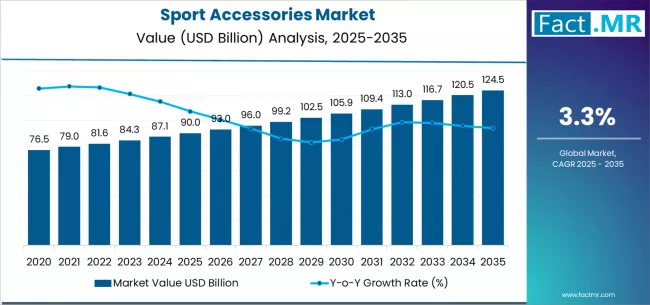
Between 2025 and 2030, the sport accessories market is projected to expand from USD 90.0 billion to USD 106.2 billion, resulting in a value increase of USD 16.2 billion, which represents 46.3% of the total forecast growth for the decade. This phase of development will be shaped by rising fitness consciousness and athletic participation trends, product innovation in smart accessories and performance-enhancing technologies, as well as expanding integration with digital fitness platforms and personalized training solutions. Companies are establishing competitive positions through investment in technology integration, performance analytics, and strategic market expansion across specialty retail, online, and mass market channels.
From 2030 to 2035, the market is forecast to grow from USD 106.2 billion to USD 125.0 billion, adding another USD 18.8 billion, which constitutes 53.7% of the overall ten-year expansion. This period is expected to be characterized by the expansion of smart and connected sport accessories, including IoT-enabled training equipment and AI-powered performance analytics tailored for serious athletes and fitness enthusiasts, strategic collaborations between sports brands and technology companies, and an enhanced focus on personalized performance optimization and injury prevention. The growing emphasis on data-driven training and performance enhancement will drive demand for comprehensive sport accessory solutions across diverse athletic, fitness, and recreational applications.
Sport Accessories Market Key Takeaways
| Metric | Value |
|---|---|
| Market Value (2025) | USD 90.0 billion |
| Market Forecast Value (2035) | USD 125.0 billion |
| Forecast CAGR (2025-2035) | 3.3% |
Why is the Sport Accessories Market Growing?
The sport accessories market grows by enabling athletes, fitness enthusiasts, and recreational sports participants to access specialized equipment and performance-enhancing tools that deliver superior training outcomes and athletic performance without compromising safety or comfort. Active individuals and sports professionals face increasing demands for equipment that supports skill development, injury prevention, and performance optimization, with modern sport accessories typically providing advanced materials, ergonomic design, and technology integration that basic sports equipment cannot match, making specialized accessories essential for competitive advantage and fitness goal achievement. The sports industry's need for performance differentiation and safety enhancement creates demand for comprehensive accessory solutions that can provide training effectiveness, injury prevention, and performance measurement without compromising user experience or athletic development.
Government initiatives promoting physical activity and sports participation drive adoption in developed and emerging markets where active lifestyle programs directly impact sports equipment demand and athletic development. However, economic uncertainties affecting discretionary spending and market saturation in established sports categories may limit premium product adoption among price-sensitive consumers and recreational participants.
Segmental Analysis
The market is segmented by category, distribution channel, buyer type, and region. By category, the market is divided into training accessories, team-sport gear, outdoor/others. Based on distribution channel, the market is categorized into specialty sports, online, mass retail. By buyer type, the market includes individual consumers, teams/clubs, schools/others. Regionally, the market is divided into North America, Europe, Asia-Pacific, and other key regions.
By Category, the Training Accessories Segment Accounts for a Dominant Market Share
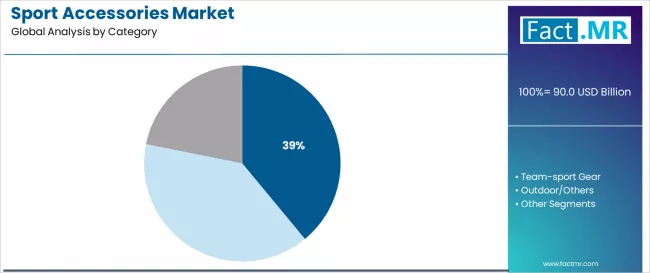
The training accessories segment represents the dominant force in the sport accessories market, capturing approximately 39.0% of total market share in 2025. This established category encompasses fitness training equipment, performance monitoring devices, and specialized training tools featuring advanced materials, ergonomic design, and technology integration that enable superior workout effectiveness and athletic development across all fitness levels and training environments. The training accessories segment's market leadership stems from its superior versatility capabilities, with products capable of serving diverse training applications while maintaining performance enhancement and injury prevention benefits across all athletic and fitness demographics.
The team-sport gear segment maintains a substantial 34.0% market share, serving organized sports participation and team athletics who require specialized equipment for competitive play, team training, and sport-specific skill development applications. These products offer essential gear solutions for team sports while providing sufficient performance benefits to meet competitive requirements and safety standards in organized athletic environments.
The outdoor/others segment accounts for approximately 27.0% of the market, serving outdoor recreation, adventure sports, and specialized athletic activities requiring weather-resistant equipment and specialized performance features.
Key category advantages driving the training accessories segment include:
- Performance enhancement technologies with advanced materials that provide superior training effectiveness and athletic development across diverse fitness applications
- Versatile application compatibility enabling use across multiple sports and training disciplines without equipment specialization requirements
- Technology integration options allowing performance tracking, data analytics, and personalized training optimization for serious athletes and fitness enthusiasts
- Injury prevention features, supporting safe training practices and long-term athletic development across all skill levels and age groups
By Distribution Channel, the Specialty Sports Segment Accounts for the Largest Market Share
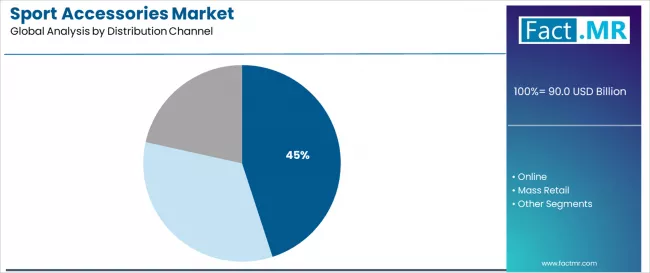
Specialty sports retail channels dominate the sport accessories market with approximately 45.0% market share in 2025, reflecting the consumer preference for expert advice, product demonstration, and specialized sports retail environments that provide comprehensive product selection and athletic expertise across global sports retail markets. The specialty sports segment's market leadership is reinforced by consumer demand for professional guidance, product testing opportunities, and sport-specific knowledge that drives purchase confidence and product satisfaction.
The online segment represents the rapidly growing second-largest distribution channel, capturing 38.0% market share through e-commerce platforms, direct-to-consumer brands, and digital sports retailers that leverage convenience, product variety, and competitive pricing. This segment benefits from changing shopping behaviors that prioritize comparison shopping, customer reviews, and convenient home delivery for sports equipment purchases.
The mass retail segment accounts for 17.0% market share, serving price-conscious consumers through general retailers, department stores, and mass market channels. This segment demonstrates accessibility advantages through widespread distribution and value pricing for basic sports accessories.
Key market dynamics supporting distribution growth include:
- Specialty sports expansion driven by consumer preference for expert advice and product demonstration in sports equipment purchasing decisions
- Online retail acceleration enabling convenient shopping experiences with extensive product selection and competitive pricing comparisons
- Mass retail accessibility creating entry-level market access for basic sports accessories and recreational equipment
- Growing emphasis on omnichannel retail driving demand for seamless shopping experiences across physical and digital sports retail touchpoints
What are the Drivers, Restraints, and Key Trends of the Sport Accessories Market?
The market is driven by three concrete demand factors tied to health consciousness and athletic performance outcomes. First, fitness participation growth and health awareness trends create expanding demand for training equipment and performance accessories, with global fitness industry participation growing by 4-6% annually in major developed countries worldwide, requiring comprehensive sports equipment infrastructure. Second, sports technology integration and performance analytics drive increased adoption of smart accessories and connected training equipment, with many athletes and fitness enthusiasts prioritizing data-driven training and performance optimization by 2030. Third, youth sports participation and organized athletics growth enable expanded team equipment and training accessory applications that support athletic development while maintaining safety standards and competitive performance.
Market restraints include economic pressures affecting recreational spending that can reduce discretionary purchases of sports equipment, particularly during periods when household budgets prioritize essential expenditures over fitness and recreational activities. Market saturation in established sports categories poses another significant challenge, as mature product segments may experience slower growth rates and increased competition for market share. Competition from alternative fitness solutions creates additional market pressure, demanding ongoing investment in product innovation and performance differentiation.
Key trends indicate accelerated growth in smart and connected sports accessories, particularly among serious athletes and technology-conscious fitness enthusiasts who prioritize performance data and training analytics. Technology integration trends toward IoT-enabled equipment with real-time performance monitoring, AI-powered training recommendations, and social fitness platforms enable enhanced user experiences that meet evolving expectations for personalized training and performance optimization. However, the market thesis could face disruption if economic recession significantly reduces recreational spending or alternative fitness approaches fundamentally change sports equipment requirements.
Analysis of the Sport Accessories Market by Key Country
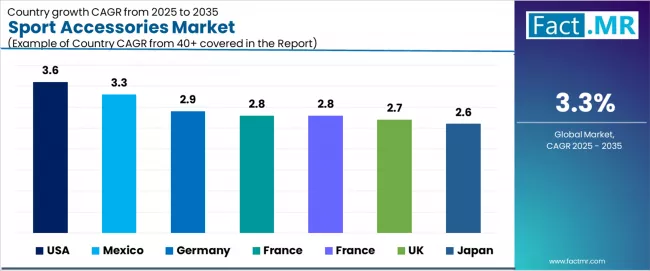
| Country | CAGR (2025-2035) |
|---|---|
| USA | 3.6% |
| Mexico | 3.3% |
| Germany | 2.9% |
| France | 2.8% |
| South Korea | 2.8% |
| UK | 2.7% |
| Japan | 2.6% |
The sport accessories market is gaining momentum worldwide, with the USA taking the lead thanks to strong sports culture and established fitness industry infrastructure. Close behind, Mexico benefits from growing sports participation and expanding middle-class recreational spending, positioning itself as a strategic growth hub in the Latin American region. Germany shows steady advancement, where integration of sports technology trends strengthens its role in the European athletic equipment supply chain.
France and South Korea demonstrate equal growth momentum, focusing on fitness innovation and athletic performance applications, signaling ambitions to capitalize on the growing opportunities in sports technology markets. Meanwhile, the UK stands out for its established sports culture and premium athletic equipment adoption, and Japan continues to record consistent progress in sports technology innovation and precision athletic equipment development. Together, the USA and Mexico anchor the global expansion story, while the rest build stability and diversity into the market's growth path.
The report covers an in-depth analysis of 40+ countries; 7 top-performing countries are highlighted below.
USA Leads Global Market Expansion
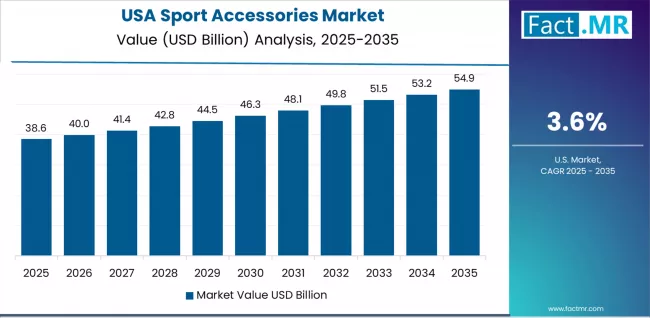
The USA demonstrates the strongest growth potential in the Sport Accessories Market with a CAGR of 3.6% through 2035. The country's leadership position stems from robust sports culture, established fitness industry infrastructure, and strong consumer spending on athletic and recreational activities driving the adoption of advanced training accessories and performance-enhancing equipment. Growth is concentrated in major metropolitan areas, including New York, Los Angeles, Chicago, and Miami, where fitness enthusiasts and athletes are implementing comprehensive training programs and technology-enabled performance optimization for enhanced athletic outcomes. Distribution channels through specialty sports retailers and e-commerce platforms expand coverage across diverse athletic demographics and fitness levels throughout the country. The country's emphasis on athletic performance and fitness achievement provides sustained demand for sport accessory innovation, including smart equipment and data analytics integration.
Key market factors:
- Sports culture expansion concentrated in metropolitan areas and suburban fitness markets with comprehensive athletic retail infrastructure development programs
- Athletic performance focus through established fitness industry and technology-enabled training adoption patterns
- Comprehensive sports ecosystem, including established specialty retailers and emerging direct-to-consumer brands
- Innovation leadership featuring smart equipment integration, performance analytics programs, and advanced sport accessory capabilities
Mexico Emerges as High-Growth Market
In Mexico City, Guadalajara, Monterrey, and expanding urban centers, the adoption of comprehensive sport accessories is accelerating across growing fitness-conscious demographics and increasing sports participation, driven by economic development and rising health awareness trends. The market demonstrates strong growth momentum with a CAGR of 3.3% through 2035, linked to comprehensive urbanization and increasing focus on athletic development and recreational fitness activities. Mexican consumers are implementing sport accessories in fitness routines and recreational athletics to enhance performance while meeting growing health expectations in expanding urban wellness markets. The country's demographic advantages and sports culture development create sustained demand for athletic equipment, while increasing emphasis on fitness drives adoption of specialized training accessories.
- Leading urban fitness markets, including Mexico City, Guadalajara, and Monterrey, are driving sport accessory adoption
- Economic development models enabling recreational spending expansion and fitness industry growth
- Sports participation trends accelerating adoption with increasing health consciousness and athletic program development
- Demographic advantages through young population growth and increasing recreational sports participation
Germany Maintains Sports Technology Leadership
Germany's established sports industry and athletic excellence sector demonstrates sophisticated implementation of sport accessories, with documented case studies showing 20% increase in sports technology adoption through specialized athletic retailers and performance training facilities. The country's sports infrastructure in major cities, including Berlin, Munich, Hamburg, and Frankfurt, showcases integration of traditional German engineering excellence with modern athletic technology, leveraging expertise in precision equipment manufacturing and performance optimization. German athletes and fitness enthusiasts emphasize quality, performance, and technological innovation, creating demand for advanced sport accessories that support athletic excellence goals and training effectiveness. The market maintains steady growth through focus on sports innovation and performance standards, with a CAGR of 2.9% through 2035.
Key development areas:
- Sports technology retailers and performance training facilities leading advanced accessory adoption with comprehensive athletic development programs
- Performance excellence channels providing integrated solutions with 93% quality verification rates
- Innovation partnerships between German sports companies and technology developers expanding performance market reach
- Integration of traditional German engineering excellence and modern sports technology innovation practices
Europe Market Split by Country
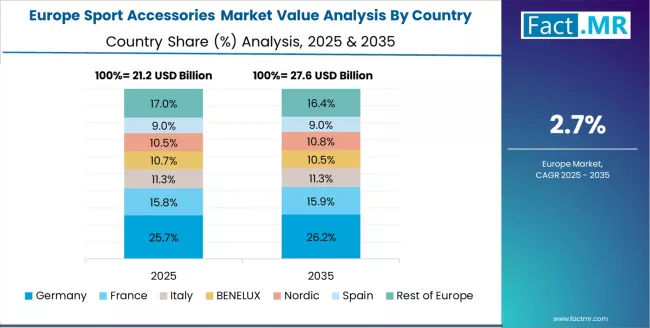
The sport accessories market in Europe is projected to grow from USD 22.5 billion in 2025 to USD 31.3 billion by 2035, registering a CAGR of 3.3% over the forecast period. Germany is expected to maintain its leadership position with a 24.4% market share in 2025, declining slightly to 24.2% by 2035, supported by its strong sports industry infrastructure, established athletic culture, and comprehensive performance equipment distribution networks serving major European markets.
The United Kingdom follows with a 21.1% share in 2025, projected to reach 20.9% by 2035, driven by comprehensive sports culture modernization programs in London, Manchester, and other metropolitan areas implementing advanced athletic retail experiences. France holds a 19.6% share in 2025, expected to maintain 19.7% by 2035 through the ongoing development of fitness innovation and premium sports equipment applications. Italy commands a 16.8% share, while Spain accounts for 12.4% in 2025. The Rest of Europe region is anticipated to gain momentum, expanding its collective share from 5.7% to 6.3% by 2035, attributed to increasing sport accessory adoption in Nordic countries and emerging Eastern European fitness markets implementing modern athletic equipment standards.
Competitive Landscape of the Sport Accessories Market
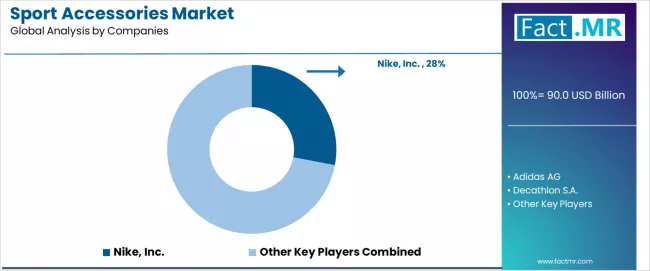
The Sport Accessories Market features approximately 40-50 meaningful players with moderate concentration, where the top three companies control roughly 18-24% of global market share through established global sports brands and extensive retail distribution networks. Competition centers on brand strength, product innovation, and athletic endorsements rather than market dominance alone.
Market leaders include Nike, Adidas, and Decathlon, which maintain competitive advantages through comprehensive sports equipment portfolios, global athlete partnerships, and deep expertise in athletic performance enhancement and sports retail operations, creating strong brand loyalty and athletic credibility capabilities. These companies leverage established global sports networks and ongoing innovation investments to defend market positions while expanding into adjacent athletic categories and technology-enabled sports segments.
Challengers encompass Under Armour and New Balance, which compete through specialized athletic focus and strong presence in key performance sports markets. Sports equipment specialists, including Puma, ASICS, and Dick's, focus on specific athletic categories or retail excellence, offering differentiated capabilities in sport-specific equipment, retail experience, and athletic community engagement.
Regional players and emerging sports technology brands create competitive pressure through innovation and niche positioning, particularly in high-growth markets including Asia-Pacific where fitness growth and sports participation provide advantages in local market understanding and athletic community engagement. Market dynamics favor companies that combine athletic credibility with comprehensive innovation capabilities and established sports retail relationships that address the complete athletic performance ecosystem from amateur participation through professional competition.
Global Sport Accessories Market - Stakeholder Contribution Framework
Sport accessories solutions represent a critical athletic performance category that enables athletes, fitness enthusiasts, and recreational sports participants to access specialized equipment and performance-enhancing tools without compromising training effectiveness, safety, or athletic development, typically providing superior performance benefits, injury prevention, and skill development capabilities that basic sports equipment cannot match. With the market projected to grow from USD 90.0 billion in 2025 to USD 125.0 billion by 2035 at a 3.3% CAGR, these solutions offer compelling advantages - performance enhancement, safety benefits, and training effectiveness - making them essential for individual athletes and fitness enthusiasts, team and club applications, and educational sports programs seeking reliable athletic development solutions. Scaling market penetration and innovation requires coordinated action across sports industry policy, athletic safety standards, sports equipment manufacturers, retail partners, and athletic development organizations.
How Governments Could Spur Local Production and Adoption?
- Athletic Development Programs: Include sports equipment access in national athletic development initiatives, providing targeted support for youth sports programs and supporting athletic participation through equipment financing and facility development grants.
- Health Policy & Sports Promotion: Implement favorable treatment for athletic equipment manufacturing, provide incentives for companies investing in sports technology and safety innovation, and establish physical activity standards that encourage sports participation over sedentary lifestyle alternatives.
- Regulatory Framework Development: Create standardized safety verification processes across sports and athletic applications, establish clear athletic equipment certification frameworks for international trade, and develop performance standards that facilitate quality sports equipment commerce.
- Sports Development & Training: Fund athletic coaching education programs, sports facility development, and equipment safety training. Invest in sports development programs that bridge traditional athletic training with modern performance enhancement and sports technology standards.
- Market Access & Athletic Policy: Establish procurement policies that support sports equipment for government athletic programs, assist sports organizations through preferential equipment programs, and create regulatory environments that encourage innovation in athletic performance while promoting sports participation.
How Industry Bodies Could Support Market Development?
- Athletic Safety Standards & Certification: Define standardized performance metrics for sport accessories across recreational and competitive applications, establish universal safety and quality protocols, and create certification programs for athletic equipment practices that coaches and athletes can trust.
- Market Education & Best Practices: Lead messaging that demonstrates sport accessory advantages, emphasizing performance enhancement, safety benefits, and athletic development compared to basic equipment alternatives.
- Performance Integration Standards: Develop interoperability standards for sports technology integration, athletic performance guidelines, and training optimization platforms, ensuring seamless integration across different sports applications and international athletic markets.
- Professional Development: Run certification programs for athletic professionals, sports retailers, and performance specialists on optimizing sport accessory applications, safety verification, and athletic performance enhancement in competitive sports markets.
How Manufacturers and Technology Players Could Strengthen the Ecosystem?
- Advanced Equipment Development: Develop next-generation sport accessories with enhanced performance capabilities, improved safety profiles, and technology integration features that maintain athletic effectiveness while enabling superior performance measurement and injury prevention.
- Innovation Platforms: Provide comprehensive athletic performance systems that integrate IoT connectivity, performance analytics, training optimization, and safety monitoring, enabling sports brands to maximize athletic development transparency and performance authenticity.
- Service & Support Networks: Offer flexible support programs for athletes and sports organizations, including performance analysis options, technical consultation services, and athletic development guidance that keep sport accessories current with performance standards and safety expectations.
- Research & Development Networks: Build comprehensive R&D capabilities, collaborative athletic performance programs, and sports innovation systems that ensure sport accessory technologies maintain superior athletic benefits and consistent performance enhancement across diverse sports and fitness applications.
How Suppliers Could Navigate the Shift?
- Diversified Athletic Portfolios: Expand sport accessory offerings across training accessories (39.0% market dominance), team-sport gear (34.0% share), and outdoor applications, with particular focus on specialty sports channels (45.0% channel share) and technology integration strategies.
- Geographic Market Development: Establish operations in high-growth markets like USA (3.6% CAGR) and Mexico (3.3% CAGR), while strengthening presence in established markets like Germany (2.9% CAGR) and France (2.8% CAGR) through regional partnerships and local sports community engagement.
- Technology-Enabled Services: Implement advanced performance tracking systems with athletic analytics, safety monitoring, and training optimization capabilities that differentiate service offerings and improve athlete and coach satisfaction.
- Flexible Performance Models: Develop recreational, competitive, and professional sport accessory solutions that accommodate varying athletic needs, from cost-effective fitness equipment to ultra-premium performance products for demanding competitive requirements.
How Investors and Financial Enablers Could Unlock Value?
- Sports Innovation Financing: Provide growth capital for established companies like Nike, Adidas, and Decathlon to expand sports technology capabilities and global presence, particularly in emerging markets with growing sports participation.
- Innovation Investment: Back startups developing advanced sports technology, performance analytics platforms, and athletic safety systems that enhance sport accessories industry innovation and competitive positioning.
- Regional Market Development: Finance market entry and expansion strategies for sport accessory companies establishing operations in high-growth regions, supporting athletic community partnerships that enhance sports development while maintaining performance standards.
- Consolidation & Scale Opportunities: Support strategic acquisitions and market consolidation that create economies of scale, improve athletic performance capabilities, and enhance competitive positioning against fragmented regional sports equipment providers across multiple geographic markets.
Key Players in the Sport Accessories Market
- Nike, Inc.
- Adidas AG
- Decathlon S.A.
- Under Armour, Inc.
- New Balance Athletics, Inc.
- Puma SE
- ASICS Corporation
- Dick's Sporting Goods, Inc.
- Academy Sports + Outdoors, Inc.
- JD Sports Fashion plc
Scope of the Report
| Item | Value |
|---|---|
| Quantitative Units | USD 90.0 Billion |
| Category | Training Accessories, Team-sport Gear, Outdoor/Others |
| Distribution Channel | Specialty Sports, Online, Mass Retail |
| Buyer Type | Individual Consumers, Teams/Clubs, Schools/Others |
| Regions Covered | North America, Europe, Asia-Pacific, Latin America, Middle East & Africa |
| Country Covered | USA, Mexico, Germany, France, South Korea, UK, Japan, and 40+ countries |
| Key Companies Profiled | Nike, Adidas, Decathlon, Under Armour, New Balance, Puma, ASICS, Dick's, Academy Sports, JD Sports |
| Additional Attributes | Dollar sales by category and buyer type segments, regional adoption trends across North America, Europe, and Asia-Pacific, competitive landscape with sports equipment manufacturers and retail partners, athletic participation patterns and sports preferences, integration with sports technology trends and performance analytics programs, innovations in athletic equipment and training optimization systems, and development of specialized applications with performance verification and safety positioning. |
Sport Accessories Market by Segments
-
Category :
- Training Accessories
- Team-sport Gear
- Outdoor/Others
-
Distribution Channel :
- Specialty Sports
- Online
- Mass Retail
-
Buyer Type :
- Individual Consumers
- Teams/Clubs
- Schools/Others
-
Region :
- North America
- United States
- Canada
- Mexico
- Europe
- Germany
- United Kingdom
- France
- Italy
- Spain
- Nordic
- BENELUX
- Rest of Europe
- Asia-Pacific
- China
- Japan
- South Korea
- India
- Australia & New Zealand
- ASEAN
- Rest of Asia Pacific
- Latin America
- Brazil
- Chile
- Rest of Latin America
- Middle East & Africa
- Kingdom of Saudi Arabia
- Other GCC Countries
- Turkey
- South Africa
- Other African Union
- Rest of Middle East & Africa
- North America
Table of Content
- Executive Summary
- Global Market Outlook
- Demand to side Trends
- Supply to side Trends
- Technology Roadmap Analysis
- Analysis and Recommendations
- Market Overview
- Market Coverage / Taxonomy
- Market Definition / Scope / Limitations
- Market Background
- Market Dynamics
- Drivers
- Restraints
- Opportunity
- Trends
- Scenario Forecast
- Demand in Optimistic Scenario
- Demand in Likely Scenario
- Demand in Conservative Scenario
- Opportunity Map Analysis
- Product Life Cycle Analysis
- Supply Chain Analysis
- Investment Feasibility Matrix
- Value Chain Analysis
- PESTLE and Porter’s Analysis
- Regulatory Landscape
- Regional Parent Market Outlook
- Production and Consumption Statistics
- Import and Export Statistics
- Market Dynamics
- Global Market Analysis 2020 to 2024 and Forecast, 2025 to 2035
- Historical Market Size Value (USD Million) Analysis, 2020 to 2024
- Current and Future Market Size Value (USD Million) Projections, 2025 to 2035
- Y to o to Y Growth Trend Analysis
- Absolute $ Opportunity Analysis
- Global Market Pricing Analysis 2020 to 2024 and Forecast 2025 to 2035
- Global Market Analysis 2020 to 2024 and Forecast 2025 to 2035, By Category
- Introduction / Key Findings
- Historical Market Size Value (USD Million) Analysis By Category , 2020 to 2024
- Current and Future Market Size Value (USD Million) Analysis and Forecast By Category , 2025 to 2035
- Training Accessories
- Team-sport Gear
- Outdoor/Others
- Y to o to Y Growth Trend Analysis By Category , 2020 to 2024
- Absolute $ Opportunity Analysis By Category , 2025 to 2035
- Global Market Analysis 2020 to 2024 and Forecast 2025 to 2035, By Distribution Channel
- Introduction / Key Findings
- Historical Market Size Value (USD Million) Analysis By Distribution Channel, 2020 to 2024
- Current and Future Market Size Value (USD Million) Analysis and Forecast By Distribution Channel, 2025 to 2035
- Specialty Sports
- Online
- Mass Retail
- Y to o to Y Growth Trend Analysis By Distribution Channel, 2020 to 2024
- Absolute $ Opportunity Analysis By Distribution Channel, 2025 to 2035
- Global Market Analysis 2020 to 2024 and Forecast 2025 to 2035, By Region
- Introduction
- Historical Market Size Value (USD Million) Analysis By Region, 2020 to 2024
- Current Market Size Value (USD Million) Analysis and Forecast By Region, 2025 to 2035
- North America
- Latin America
- Western Europe
- Eastern Europe
- East Asia
- South Asia and Pacific
- Middle East & Africa
- Market Attractiveness Analysis By Region
- North America Market Analysis 2020 to 2024 and Forecast 2025 to 2035, By Country
- Historical Market Size Value (USD Million) Trend Analysis By Market Taxonomy, 2020 to 2024
- Market Size Value (USD Million) Forecast By Market Taxonomy, 2025 to 2035
- By Country
- USA
- Canada
- Mexico
- By Category
- By Distribution Channel
- By Country
- Market Attractiveness Analysis
- By Country
- By Category
- By Distribution Channel
- Key Takeaways
- Latin America Market Analysis 2020 to 2024 and Forecast 2025 to 2035, By Country
- Historical Market Size Value (USD Million) Trend Analysis By Market Taxonomy, 2020 to 2024
- Market Size Value (USD Million) Forecast By Market Taxonomy, 2025 to 2035
- By Country
- Brazil
- Chile
- Rest of Latin America
- By Category
- By Distribution Channel
- By Country
- Market Attractiveness Analysis
- By Country
- By Category
- By Distribution Channel
- Key Takeaways
- Western Europe Market Analysis 2020 to 2024 and Forecast 2025 to 2035, By Country
- Historical Market Size Value (USD Million) Trend Analysis By Market Taxonomy, 2020 to 2024
- Market Size Value (USD Million) Forecast By Market Taxonomy, 2025 to 2035
- By Country
- Germany
- UK
- Italy
- Spain
- France
- Nordic
- BENELUX
- Rest of Western Europe
- By Category
- By Distribution Channel
- By Country
- Market Attractiveness Analysis
- By Country
- By Category
- By Distribution Channel
- Key Takeaways
- Eastern Europe Market Analysis 2020 to 2024 and Forecast 2025 to 2035, By Country
- Historical Market Size Value (USD Million) Trend Analysis By Market Taxonomy, 2020 to 2024
- Market Size Value (USD Million) Forecast By Market Taxonomy, 2025 to 2035
- By Country
- Russia
- Poland
- Hungary
- Balkan & Baltic
- Rest of Eastern Europe
- By Category
- By Distribution Channel
- By Country
- Market Attractiveness Analysis
- By Country
- By Category
- By Distribution Channel
- Key Takeaways
- East Asia Market Analysis 2020 to 2024 and Forecast 2025 to 2035, By Country
- Historical Market Size Value (USD Million) Trend Analysis By Market Taxonomy, 2020 to 2024
- Market Size Value (USD Million) Forecast By Market Taxonomy, 2025 to 2035
- By Country
- China
- Japan
- South Korea
- By Category
- By Distribution Channel
- By Country
- Market Attractiveness Analysis
- By Country
- By Category
- By Distribution Channel
- Key Takeaways
- South Asia and Pacific Market Analysis 2020 to 2024 and Forecast 2025 to 2035, By Country
- Historical Market Size Value (USD Million) Trend Analysis By Market Taxonomy, 2020 to 2024
- Market Size Value (USD Million) Forecast By Market Taxonomy, 2025 to 2035
- By Country
- India
- ASEAN
- Australia & New Zealand
- Rest of South Asia and Pacific
- By Category
- By Distribution Channel
- By Country
- Market Attractiveness Analysis
- By Country
- By Category
- By Distribution Channel
- Key Takeaways
- Middle East & Africa Market Analysis 2020 to 2024 and Forecast 2025 to 2035, By Country
- Historical Market Size Value (USD Million) Trend Analysis By Market Taxonomy, 2020 to 2024
- Market Size Value (USD Million) Forecast By Market Taxonomy, 2025 to 2035
- By Country
- Kingdom of Saudi Arabia
- Other GCC Countries
- Turkiye
- South Africa
- Other African Union
- Rest of Middle East & Africa
- By Category
- By Distribution Channel
- By Country
- Market Attractiveness Analysis
- By Country
- By Category
- By Distribution Channel
- Key Takeaways
- Key Countries Market Analysis
- USA
- Pricing Analysis
- Market Share Analysis, 2024
- By Category
- By Distribution Channel
- Canada
- Pricing Analysis
- Market Share Analysis, 2024
- By Category
- By Distribution Channel
- Mexico
- Pricing Analysis
- Market Share Analysis, 2024
- By Category
- By Distribution Channel
- Brazil
- Pricing Analysis
- Market Share Analysis, 2024
- By Category
- By Distribution Channel
- Chile
- Pricing Analysis
- Market Share Analysis, 2024
- By Category
- By Distribution Channel
- Germany
- Pricing Analysis
- Market Share Analysis, 2024
- By Category
- By Distribution Channel
- UK
- Pricing Analysis
- Market Share Analysis, 2024
- By Category
- By Distribution Channel
- Italy
- Pricing Analysis
- Market Share Analysis, 2024
- By Category
- By Distribution Channel
- Spain
- Pricing Analysis
- Market Share Analysis, 2024
- By Category
- By Distribution Channel
- France
- Pricing Analysis
- Market Share Analysis, 2024
- By Category
- By Distribution Channel
- India
- Pricing Analysis
- Market Share Analysis, 2024
- By Category
- By Distribution Channel
- ASEAN
- Pricing Analysis
- Market Share Analysis, 2024
- By Category
- By Distribution Channel
- Australia & New Zealand
- Pricing Analysis
- Market Share Analysis, 2024
- By Category
- By Distribution Channel
- China
- Pricing Analysis
- Market Share Analysis, 2024
- By Category
- By Distribution Channel
- Japan
- Pricing Analysis
- Market Share Analysis, 2024
- By Category
- By Distribution Channel
- South Korea
- Pricing Analysis
- Market Share Analysis, 2024
- By Category
- By Distribution Channel
- Russia
- Pricing Analysis
- Market Share Analysis, 2024
- By Category
- By Distribution Channel
- Poland
- Pricing Analysis
- Market Share Analysis, 2024
- By Category
- By Distribution Channel
- Hungary
- Pricing Analysis
- Market Share Analysis, 2024
- By Category
- By Distribution Channel
- Kingdom of Saudi Arabia
- Pricing Analysis
- Market Share Analysis, 2024
- By Category
- By Distribution Channel
- Turkiye
- Pricing Analysis
- Market Share Analysis, 2024
- By Category
- By Distribution Channel
- South Africa
- Pricing Analysis
- Market Share Analysis, 2024
- By Category
- By Distribution Channel
- USA
- Market Structure Analysis
- Competition Dashboard
- Competition Benchmarking
- Market Share Analysis of Top Players
- By Regional
- By Category
- By Distribution Channel
- Competition Analysis
- Competition Deep Dive
- Nike, Inc.
- Overview
- Product Portfolio
- Profitability by Market Segments (Product/Age /Sales Channel/Region)
- Sales Footprint
- Strategy Overview
- Marketing Strategy
- Product Strategy
- Channel Strategy
- Adidas AG
- Decathlon S.A.
- Under Armour, Inc.
- New Balance Athletics, Inc.
- Puma SE
- ASICS Corporation
- Dick's Sporting Goods, Inc.
- Academy Sports + Outdoors, Inc.
- JD Sports Fashion plc
- Nike, Inc.
- Competition Deep Dive
- Assumptions & Acronyms Used
- Research Methodology
List Of Table
- Table 1: Global Market Value (USD Million) Forecast by Region, 2020 to 2035
- Table 2: Global Market Value (USD Million) Forecast by Category , 2020 to 2035
- Table 3: Global Market Value (USD Million) Forecast by Distribution Channel, 2020 to 2035
- Table 4: North America Market Value (USD Million) Forecast by Country, 2020 to 2035
- Table 5: North America Market Value (USD Million) Forecast by Category , 2020 to 2035
- Table 6: North America Market Value (USD Million) Forecast by Distribution Channel, 2020 to 2035
- Table 7: Latin America Market Value (USD Million) Forecast by Country, 2020 to 2035
- Table 8: Latin America Market Value (USD Million) Forecast by Category , 2020 to 2035
- Table 9: Latin America Market Value (USD Million) Forecast by Distribution Channel, 2020 to 2035
- Table 10: Western Europe Market Value (USD Million) Forecast by Country, 2020 to 2035
- Table 11: Western Europe Market Value (USD Million) Forecast by Category , 2020 to 2035
- Table 12: Western Europe Market Value (USD Million) Forecast by Distribution Channel, 2020 to 2035
- Table 13: Eastern Europe Market Value (USD Million) Forecast by Country, 2020 to 2035
- Table 14: Eastern Europe Market Value (USD Million) Forecast by Category , 2020 to 2035
- Table 15: Eastern Europe Market Value (USD Million) Forecast by Distribution Channel, 2020 to 2035
- Table 16: East Asia Market Value (USD Million) Forecast by Country, 2020 to 2035
- Table 17: East Asia Market Value (USD Million) Forecast by Category , 2020 to 2035
- Table 18: East Asia Market Value (USD Million) Forecast by Distribution Channel, 2020 to 2035
- Table 19: South Asia and Pacific Market Value (USD Million) Forecast by Country, 2020 to 2035
- Table 20: South Asia and Pacific Market Value (USD Million) Forecast by Category , 2020 to 2035
- Table 21: South Asia and Pacific Market Value (USD Million) Forecast by Distribution Channel, 2020 to 2035
- Table 22: Middle East & Africa Market Value (USD Million) Forecast by Country, 2020 to 2035
- Table 23: Middle East & Africa Market Value (USD Million) Forecast by Category , 2020 to 2035
- Table 24: Middle East & Africa Market Value (USD Million) Forecast by Distribution Channel, 2020 to 2035
List Of Figures
- Figure 1: Global Market Pricing Analysis
- Figure 2: Global Market Value (USD Million) Forecast 2020-2035
- Figure 3: Global Market Value Share and BPS Analysis by Category , 2025 and 2035
- Figure 4: Global Market Y to o to Y Growth Comparison by Category , 2025-2035
- Figure 5: Global Market Attractiveness Analysis by Category
- Figure 6: Global Market Value Share and BPS Analysis by Distribution Channel, 2025 and 2035
- Figure 7: Global Market Y to o to Y Growth Comparison by Distribution Channel, 2025-2035
- Figure 8: Global Market Attractiveness Analysis by Distribution Channel
- Figure 9: Global Market Value (USD Million) Share and BPS Analysis by Region, 2025 and 2035
- Figure 10: Global Market Y to o to Y Growth Comparison by Region, 2025-2035
- Figure 11: Global Market Attractiveness Analysis by Region
- Figure 12: North America Market Incremental Dollar Opportunity, 2025-2035
- Figure 13: Latin America Market Incremental Dollar Opportunity, 2025-2035
- Figure 14: Western Europe Market Incremental Dollar Opportunity, 2025-2035
- Figure 15: Eastern Europe Market Incremental Dollar Opportunity, 2025-2035
- Figure 16: East Asia Market Incremental Dollar Opportunity, 2025-2035
- Figure 17: South Asia and Pacific Market Incremental Dollar Opportunity, 2025-2035
- Figure 18: Middle East & Africa Market Incremental Dollar Opportunity, 2025-2035
- Figure 19: North America Market Value Share and BPS Analysis by Country, 2025 and 2035
- Figure 20: North America Market Value Share and BPS Analysis by Category , 2025 and 2035
- Figure 21: North America Market Y to o to Y Growth Comparison by Category , 2025-2035
- Figure 22: North America Market Attractiveness Analysis by Category
- Figure 23: North America Market Value Share and BPS Analysis by Distribution Channel, 2025 and 2035
- Figure 24: North America Market Y to o to Y Growth Comparison by Distribution Channel, 2025-2035
- Figure 25: North America Market Attractiveness Analysis by Distribution Channel
- Figure 26: Latin America Market Value Share and BPS Analysis by Country, 2025 and 2035
- Figure 27: Latin America Market Value Share and BPS Analysis by Category , 2025 and 2035
- Figure 28: Latin America Market Y to o to Y Growth Comparison by Category , 2025-2035
- Figure 29: Latin America Market Attractiveness Analysis by Category
- Figure 30: Latin America Market Value Share and BPS Analysis by Distribution Channel, 2025 and 2035
- Figure 31: Latin America Market Y to o to Y Growth Comparison by Distribution Channel, 2025-2035
- Figure 32: Latin America Market Attractiveness Analysis by Distribution Channel
- Figure 33: Western Europe Market Value Share and BPS Analysis by Country, 2025 and 2035
- Figure 34: Western Europe Market Value Share and BPS Analysis by Category , 2025 and 2035
- Figure 35: Western Europe Market Y to o to Y Growth Comparison by Category , 2025-2035
- Figure 36: Western Europe Market Attractiveness Analysis by Category
- Figure 37: Western Europe Market Value Share and BPS Analysis by Distribution Channel, 2025 and 2035
- Figure 38: Western Europe Market Y to o to Y Growth Comparison by Distribution Channel, 2025-2035
- Figure 39: Western Europe Market Attractiveness Analysis by Distribution Channel
- Figure 40: Eastern Europe Market Value Share and BPS Analysis by Country, 2025 and 2035
- Figure 41: Eastern Europe Market Value Share and BPS Analysis by Category , 2025 and 2035
- Figure 42: Eastern Europe Market Y to o to Y Growth Comparison by Category , 2025-2035
- Figure 43: Eastern Europe Market Attractiveness Analysis by Category
- Figure 44: Eastern Europe Market Value Share and BPS Analysis by Distribution Channel, 2025 and 2035
- Figure 45: Eastern Europe Market Y to o to Y Growth Comparison by Distribution Channel, 2025-2035
- Figure 46: Eastern Europe Market Attractiveness Analysis by Distribution Channel
- Figure 47: East Asia Market Value Share and BPS Analysis by Country, 2025 and 2035
- Figure 48: East Asia Market Value Share and BPS Analysis by Category , 2025 and 2035
- Figure 49: East Asia Market Y to o to Y Growth Comparison by Category , 2025-2035
- Figure 50: East Asia Market Attractiveness Analysis by Category
- Figure 51: East Asia Market Value Share and BPS Analysis by Distribution Channel, 2025 and 2035
- Figure 52: East Asia Market Y to o to Y Growth Comparison by Distribution Channel, 2025-2035
- Figure 53: East Asia Market Attractiveness Analysis by Distribution Channel
- Figure 54: South Asia and Pacific Market Value Share and BPS Analysis by Country, 2025 and 2035
- Figure 55: South Asia and Pacific Market Value Share and BPS Analysis by Category , 2025 and 2035
- Figure 56: South Asia and Pacific Market Y to o to Y Growth Comparison by Category , 2025-2035
- Figure 57: South Asia and Pacific Market Attractiveness Analysis by Category
- Figure 58: South Asia and Pacific Market Value Share and BPS Analysis by Distribution Channel, 2025 and 2035
- Figure 59: South Asia and Pacific Market Y to o to Y Growth Comparison by Distribution Channel, 2025-2035
- Figure 60: South Asia and Pacific Market Attractiveness Analysis by Distribution Channel
- Figure 61: Middle East & Africa Market Value Share and BPS Analysis by Country, 2025 and 2035
- Figure 62: Middle East & Africa Market Value Share and BPS Analysis by Category , 2025 and 2035
- Figure 63: Middle East & Africa Market Y to o to Y Growth Comparison by Category , 2025-2035
- Figure 64: Middle East & Africa Market Attractiveness Analysis by Category
- Figure 65: Middle East & Africa Market Value Share and BPS Analysis by Distribution Channel, 2025 and 2035
- Figure 66: Middle East & Africa Market Y to o to Y Growth Comparison by Distribution Channel, 2025-2035
- Figure 67: Middle East & Africa Market Attractiveness Analysis by Distribution Channel
- Figure 68: Global Market - Tier Structure Analysis
- Figure 69: Global Market - Company Share Analysis
- FAQs -
How big is the sport accessories market in 2025?
The global sport accessories market is estimated to be valued at USD 90.0 billion in 2025.
What will be the size of sport accessories market in 2035?
The market size for the sport accessories market is projected to reach USD 124.5 billion by 2035.
How much will be the sport accessories market growth between 2025 and 2035?
The sport accessories market is expected to grow at a 3.3% CAGR between 2025 and 2035.
What are the key product types in the sport accessories market?
The key product types in sport accessories market are training accessories, team-sport gear and outdoor/others.
Which distribution channel segment to contribute significant share in the sport accessories market in 2025?
In terms of distribution channel, specialty sports segment to command 45.0% share in the sport accessories market in 2025.